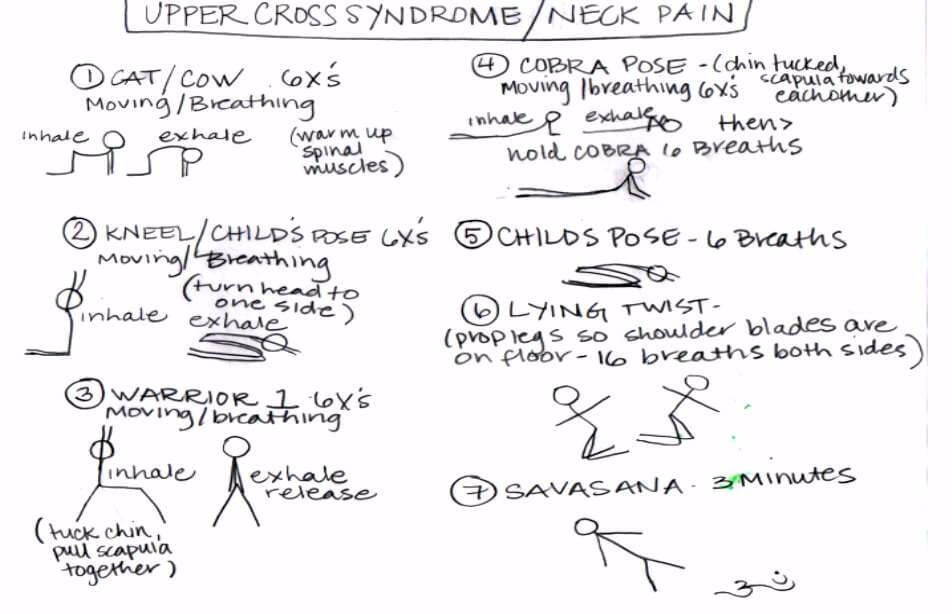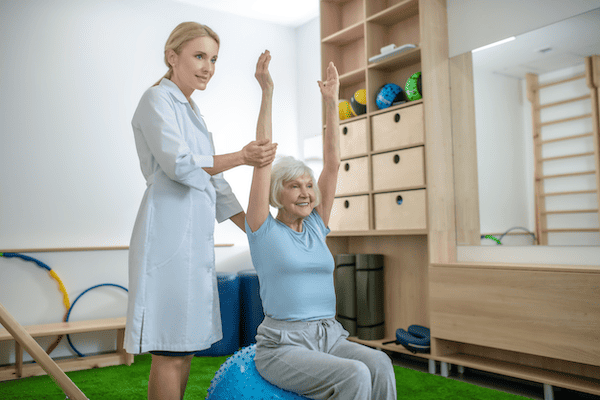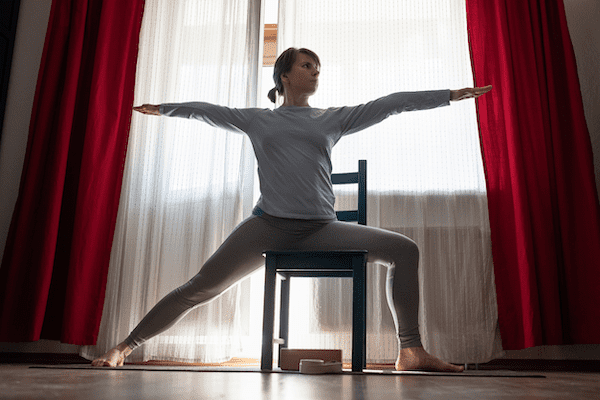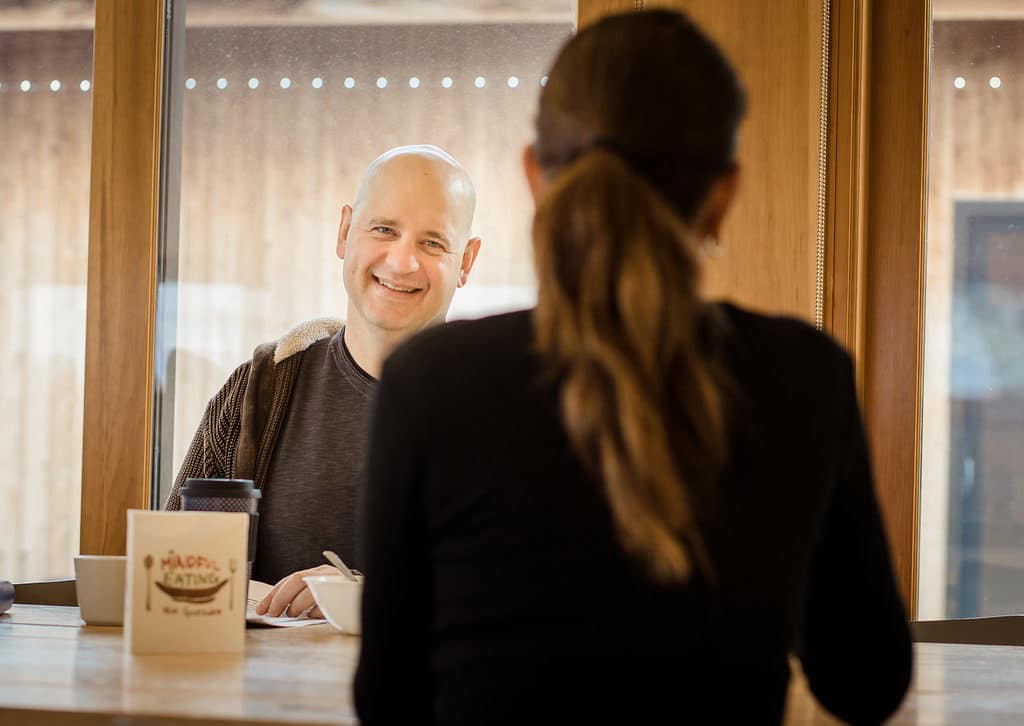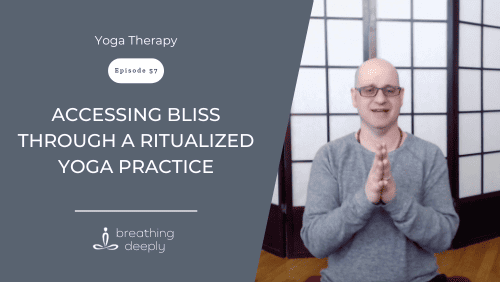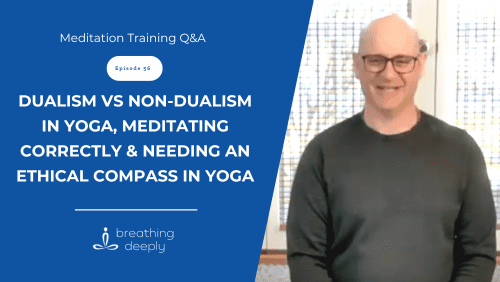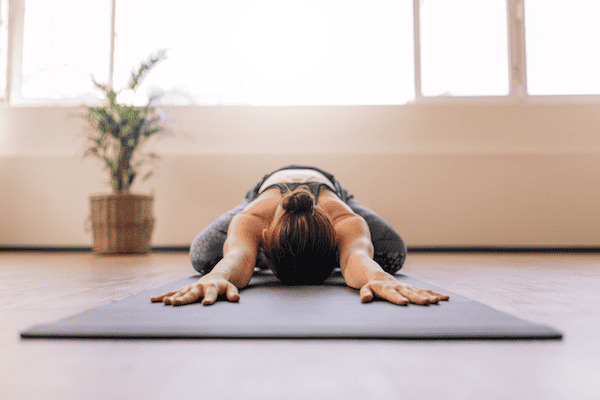
Do you experience neck pain, difficulty turning your head, or headaches? Upper Cross Syndrome, or Upper Crossed Syndrome, is a common neck problem that can manifest with a variety of symptoms. Whether you may be experiencing this issue yourself or you’re a yoga teacher or yoga therapist looking to help clients who face this problem, there are a variety of ways to use yoga for Upper Cross Syndrome with great results.
I’m Brandt Passalacqua, the Founder, Director, and Lead Teacher of Breathing Deeply, a yoga therapy training program. I’ve worked directly with numerous clients suffering from Upper Cross Syndrome and its counterpart, Lower Cross Syndrome, and trained many other yoga therapists on how to address these conditions.
Keep reading to learn more about what this syndrome is, its causes and symptoms, and how to correct it with an example sequence of 7 Upper Cross Syndrome yoga poses and breathing techniques. You can also contact us about working with myself or another yoga therapist I’ve trained to address your neck problems online, or apply to one of our programs if you’re interested in becoming a yoga therapist yourself.
Table of Contents:
- What Is Upper Cross Syndrome (or Upper Crossed Syndrome)?
- Can Upper Cross Syndrome Be Corrected?
- 7 Upper Cross Syndrome Yoga Poses in Sequence
- Upper Cross Syndrome Breathing Exercises
- Get Started with Yoga for Upper Cross Syndrome at Breathing Deeply
What Is Upper Cross Syndrome (or Upper Crossed Syndrome)?
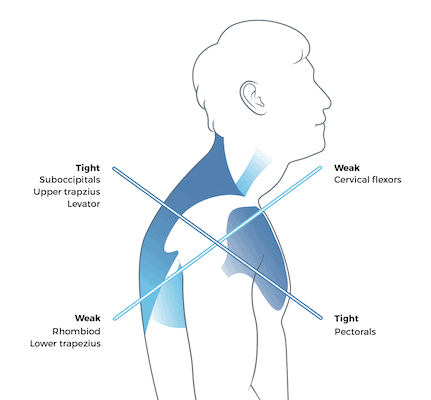
Upper Cross Syndrome (UCS), sometimes also referred to as Upper Crossed Syndrome, is a musculoskeletal disorder that is caused by muscle imbalances in the upper body. This condition is characterized by extreme muscle tightness, reduced range of motion, neck and shoulder pain, and headaches.
What Causes Upper Cross Syndrome?
Poor posture, especially from sitting for long periods of time, is the leading cause of Upper Cross Syndrome. But it can also be caused by overuse of muscles in your shoulders, neck, or upper back. If these muscles are imbalanced—whether they are too tight, weak, or overworked—it can result in Upper Cross Syndrome.
Recently, I’ve worked with a number of clients who came to me with complaints about their necks:
- One client came in for his arthritis. He said that he has always had pain in his neck around C7 (at the base of the neck).
- Another client has had constant pain in his neck near the occiput (at the base of the skull).
- I also had a client who was having trouble turning her head without pain.
Even though each person had a different story and complaint, they shared one thing in common: their posture was quite similar. Their heads were pushed forward and their shoulders were rounded, indicating Upper Cross Syndrome.
When you spend long periods of time in a hunched forward posture, your chest muscles can become shortened while your mid-back and shoulder muscles become weakened. This leads to a muscular imbalance in the upper body, where the mid-back and shoulder muscles lack the strength to counteract the muscle tightness and shortness in the neck and front of the body.
This muscular imbalance forms an “X” shape when viewed in profile, hence the name of the syndrome. It crosses from the tight upper trapezius and levator scapulae in the shoulder to tight pectorals in the upper chest, and from the weak cervical flexor muscles in the neck to the weak rhomboid and lower trapezius muscles in the upper back. The first cross is overly tight, and the second is too weak to counteract the first’s tightness.
How Many People Are Affected by Upper Cross Syndrome?

Upper Cross Syndrome affects a large number of people in a range of ages and professions. It is particularly common among:
- Office workers who spend significant time sitting at a computer
- Assembly line workers who must look down and perform repetitive tasks
- Truck drivers, cab or rideshare drivers, or those who commute long distances
- Athletes, especially swimmers and weightlifters
- Students who spend significant time sitting at a desk or computer
- The elderly, especially those who have posture or mobility issues
Repetitive movements and everyday activities that require focusing on something that is in front of the body but below the head can contribute to Upper Cross Syndrome. The condition can affect anyone who remains in a bad posture position for long periods of time.
Several studies have been done showing how Upper Cross Syndrome affects different populations:
- 67% of IT professionals have Upper Cross Syndrome, according to a study published in the International Journal of Allied Medical Sciences and Clinical Research in 2022.
- 28% of laundry workers in Karad, India and nearby rural areas have Upper Cross Syndrome, according to a study published in the Indian Journal of Occupational and Environmental Medicine in 2019.
- 2.8% of college students have Upper Cross Syndrome already and 65% have neck extensor tightness, which can lead to poor posture that can develop into Upper Cross Syndrome, according to a study published in the International Journal of Health Sciences and Research in 2022.
Can Upper Cross Syndrome Affect Breathing?
In addition to causing neck pain and headaches, Upper Cross Syndrome can affect breathing by altering the position of the rib cage and diaphragm. The tightness in the chest muscles pulls the shoulders forward and downward, which can cause the rib cage to become compressed. This can lead to a decrease in the amount of air that can be inhaled and exhaled, resulting in shallow breathing.
Additionally, the weakened mid-back muscles can cause the muscles in the neck and upper chest to work harder to lift the rib cage during inhalation, which can cause increased tension and fatigue in these muscles. This can further exacerbate the breathing difficulties associated with Upper Cross Syndrome. One of the benefits of yoga is that it can easily incorporate Upper Cross Syndrome breathing exercises.
Can Upper Cross Syndrome Be Corrected?
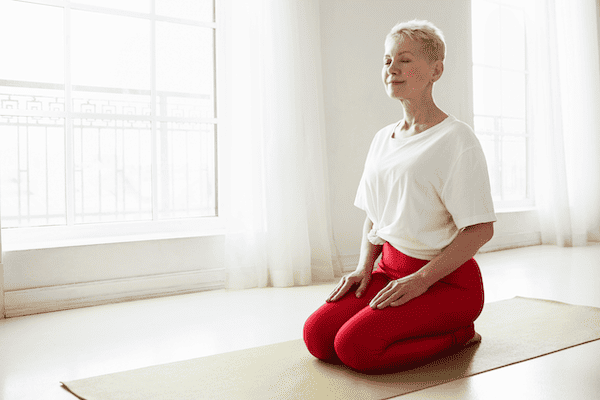
Fortunately, Upper Cross Syndrome can be corrected! When the three clients of mine I mentioned earlier corrected their postures, their symptoms diminished or vanished.
Most interesting to me is the client with arthritis. He had seen a medical doctor and a physical therapist and was convinced that he was doomed because of his diagnosis. It only took 2 minutes for me to correct his posture and get him completely out of pain!
Of course, it can take a little more time to strengthen the muscles that have been weakened to the point where your posture can be corrected for the long term. Keep reading to learn how to use yoga for Upper Cross Syndrome correction.
What Is the Best Way to Fix Upper Cross Syndrome?
Upper Cross Syndrome can be corrected with a combination of strengthening, stretching, and lifestyle changes.
- Strengthening exercises can correct the muscle weakness that has occurred, helping to encourage proper alignment and posture.
- Stretching exercises can alleviate tension in the tight muscles, reducing the imbalance between the tight and weak muscles.
- Lifestyle changes, such as breaking up or reducing repetitive movements and maintaining good posture, are also critical for addressing the root cause of the condition.
Consistency and regularity in performing these exercises are important, as well as fixing any poor posture. Yoga can be a highly effective way to fix this issue, addressing not only the strengthening and stretching exercises with effective yoga poses for Upper Cross Syndrome, but also incorporating breathing techniques and improving mental health to support these efforts.
Does Yoga Help Upper Cross Syndrome?
As mentioned above, there are plenty of highly effective ways to use yoga for Upper Cross Syndrome. Yoga can help to stretch tight muscles and strengthen weak or underactive muscles, which can alleviate tension and remedy imbalances in your posture. The most important point is to focus on strengthening muscles that keep proper alignment without forcing the body into alignment it isn’t ready for.
Yoga also possesses a few unique benefits to help with Upper Cross Syndrome:
- It can incorporate breathing techniques to help promote backbends, stimulate parasympathetic nervous system response, and relieve tension in order to combat Upper Cross Syndrome.
- It can reduce stress, anxiety, and depression, helping to improve follow-through and habit change associated with lifestyle efforts against UCS.
7 Upper Cross Syndrome Yoga Poses in Sequence
My general approach to putting Upper Cross Syndrome yoga poses in a sequence looks something like this: moving and breathing, then strengthening, then stretching. Below is a very simple sequence of yoga for Upper Cross Syndrome using this method, keeping in mind that there are a dozen other sequences to achieve the same goal.
As you can see, several rounds of moving and breathing with Cat-Cow Pose (Bitilasana), Child’s Pose (Balasana), and Warrior 1 Pose (Virabhadrasana I) prepare the joints for the static Cobra Pose (Bhujangasana), which focuses on strengthening. I recommend doing Cobra Pose while tucking the chin in order to strengthen the cervical flexors and the muscles between the scapula (shoulder blades), while also releasing the suboccipitals.
We then spend 16 breaths stretching the pecs with Supine Spinal Twist (Supta Matsyendrasana) so that they get the message to lengthen. This is followed by rest and relaxation in Corpse Pose (Savasana). And that’s it. Keep it simple, clear, and concise.
When we are using yoga poses for Upper Cross Syndrome or to help with other physical problems, my opinion is not to get fancy. It is better to be economical and clear. As yoga therapists, we work with our clients to empower them to fix their health issues.
I’ve seen this type of approach help hundreds of people suffering with neck issues. Yoga asana is really helpful and elegant if we let it be. If you are trying to help others or yourself, go for the most obvious remedy—no matter how simple it might seem—and work from that place.
1. Cat-Cow Pose (Bitilasana)
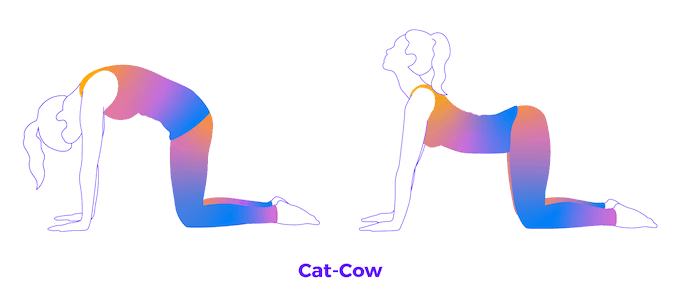
- Start on your hands and knees, with your wrists directly under your shoulders and your knees under your hips.
- As you inhale, arch your back and lift your tailbone and head towards the ceiling, creating a curve in your spine (Cow Pose).
- As you exhale, round your spine towards the ceiling, tucking your chin into your chest (Cat Pose).
- Repeat 6 times.
Cat-Cow Pose helps stretch and strengthen the neck, shoulders, and spine, improving posture and reducing tension. This makes it a great Upper Cross Syndrome yoga pose to start with. Those with physical limitations can use props like blankets or blocks for support.
2. Child’s Pose (Balasana)
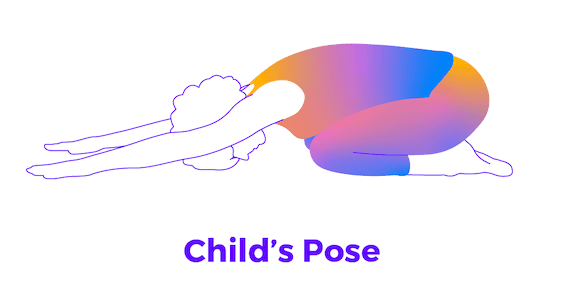
- Start by kneeling upright and bringing your big toes together.
- Raise both arms above your head and inhale.
- Fold forward at your hips as you exhale, bringing your pelvis back toward your heels, extending your arms forward on the floor in front of you, and lowering your forehead toward the floor.
- Turn your head to one side and place it against the floor.
- Repeat 6 times, alternating which side you turn your head.
Child’s Pose helps to relieve tension in the neck, shoulders, back, and hips. You can use a pillow or blanket if needed to provide cushioning for your knees or head.
3. Warrior 1 Pose (Virabhadrasana I)
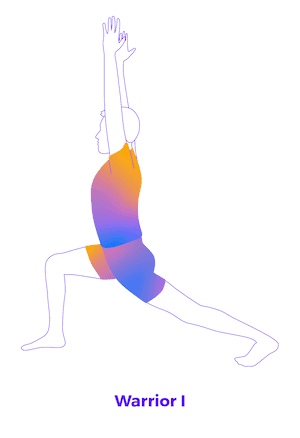
- Start by standing up and stepping forward with your right foot, 3 or 4 feet apart from your left foot.
- Bend your right knee to a 90-degree angle, so your right knee is directly above your right ankle and your right thigh is parallel to the floor.
- Turn your left foot out slightly, keeping your left leg straight.
- Inhale while raising both arms straight above your head toward the ceiling, tucking your chin toward your chest, and pulling your shoulder blades together.
- Exhale and release from the pose, moving back to a typical standing position.
- Repeat 6 times, alternating which foot you move forward.
Warrior 1 Pose helps to stretch the chest, shoulders, back, and neck. This makes it an excellent option for Upper Cross Syndrome yoga poses, since these areas are often tight in those with UCS. It also strengthens the legs, glutes, and hips, improving overall stability and balance.
In this version, we tuck the chin and pull the scapula (shoulder blades) together to address the posture imbalances of UCS. When you’re extending yourself toward the ceiling with this pose, you’re training your body to hold an upright posture, correcting the issues found in Upper Cross Syndrome.
To modify the pose, you can reduce the angle of the forward knee or widen your stance to make it easier to balance.
4. Cobra Pose (Bhujangasana)

- Start by lying on your stomach.
- Place your palms flat on the floor outside your shoulders.
- As you inhale, push on your palms to raise your head and chest, facing forward while tucking your chin.
- As you exhale, bend your elbows and drop your head and chest back onto the floor, drawing your shoulder blades together.
- Repeat 6 times.
- Pushing on your palms, raise your head and chest again, inhaling and then holding for 6 breaths.
Cobra Pose is an excellent choice when using yoga for Upper Cross Syndrome. It helps to alleviate the symptoms of UCS by strengthening the muscles between the scapula (shoulder blades) and releasing the suboccipitals, which can help to reduce neck and shoulder pain. If you have limited mobility, you can modify the pose by keeping your elbows bent.
5. Child’s Pose (Balasana) Again

- Start by kneeling upright and bringing your big toes together.
- Raise both arms above your head and inhale.
- Fold forward at your hips as you exhale, bringing your pelvis back toward your heels, extending your arms forward on the floor in front of you, and lowering your forehead to the floor.
- Hold for 6 breaths.
Child’s Pose is a restorative yoga pose that not only stretches your neck, shoulders, and back, but also helps you to de-stress. Returning to Child’s Pose here provides a restorative break in the sequence, allowing for a moment of relaxation and reflection before moving onto the next Upper Cross Syndrome yoga pose.
6. Supine Spinal Twist (Supta Matsyendrasana)
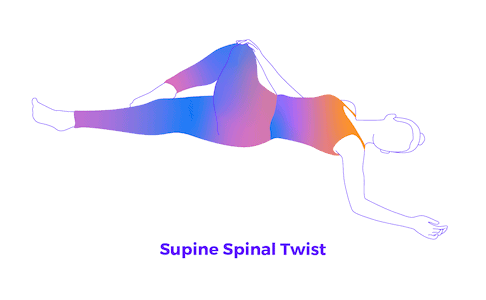
- Start by lying on your back with your arms extended out to the sides.
- Draw both knees up toward your chest.
- Bring your knees across one side of your body at the hip, keeping both shoulders on the floor still.
- If needed, you can use the hand on the same side of the body as your knees to hold them, but do not pull on your knees to force the position.
- Hold for 16 breaths, then repeat on the other side.
Supine Spinal Twist can help release tension in the neck, shoulders, and back, while also improving spinal mobility. You can modify the pose if needed by placing a cushion or block under your knees.
7. Corpse Pose (Savasana)
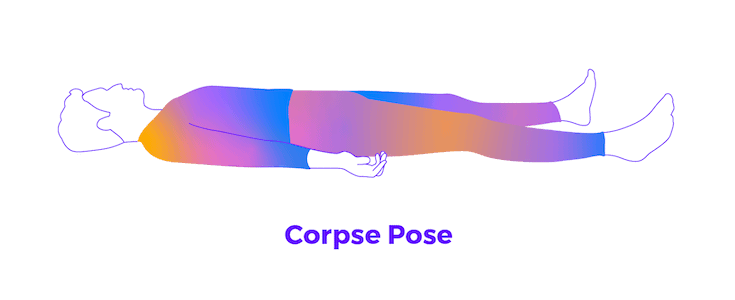
- Start by lying on your back with your head in a neutral position.
- Spread your arms and legs slightly in a starfish position.
- Release any tension in your limbs and let them rest comfortably on the floor.
- Hold for 3 minutes.
Corpse Pose is a restorative, restful pose, making it a great place to conclude a sequence of yoga for Upper Cross Syndrome. This pose helps to increase your awareness of your body and its posture while also relaxing it.
For those suffering from Upper Cross Syndrome, Corpse Pose can help to unhunch your shoulders, open your chest and neck, and release tension through the front of your body. If needed, you can use a cushion to support your head and neck.
Upper Cross Syndrome Breathing Exercises
There are a number of Upper Cross Syndrome breathing exercises you can incorporate into your yoga sequence or perform on their own.
- Inhaling during backbends, such as Cat-Cow Pose, Warrior 1 Pose, and Cobra Pose, can help expand the ribs. This helps promote backbending, which is a movement that counters the slouching of Upper Cross Syndrome.
- Deep, purposeful breathing can stimulate the parasympathetic nervous system. Regular breathwork can help to train your nervous system response, turning off your fight-or-flight response and encouraging your rest-and-digest response. When practiced in conjunction with a yoga sequence that helps correct your posture, conscious breathing can send signals to the brain that what you’re trying to do differently (keep your body upright rather than hunching over) is a good thing. This makes it easier to change your habits and improve your posture long term.
- Standalone breathing exercises can also help relieve tension generally by regulating your nervous system responses. This can reduce stress, anxiety, and depression, making it easier to follow through with new habits and lifestyle changes such as proper posture.
For those who experience shallow breathing or difficulty breathing due to Upper Cross Syndrome, breathing exercises can also help combat these symptoms.
Get Started with Yoga for Upper Cross Syndrome at Breathing Deeply

Yoga therapy, or the practice of applying yoga techniques to specific health conditions, offers people another path to good health, healing, and well-being, especially when Western medicine has failed them. For over a decade, I’ve made it my mission to make yoga therapy more accessible, both through my own private yoga therapy practice where I’ve helped thousands of clients, and through my yoga therapy programs where I’ve trained hundreds of yoga therapists.
I’ve seen firsthand how incredibly effective it can be to use yoga for Upper Cross Syndrome and other sources of neck pain. Whether you’re looking for relief for yourself or for your yoga students or clients, I’d like to help.
To become a client, contact us today about working with me or one of the yoga therapists I’ve trained. We offer private, online yoga therapy sessions via Zoom.
To become a yoga therapist yourself, learn about our yoga therapy training programs and apply today. New classes will be starting soon!

